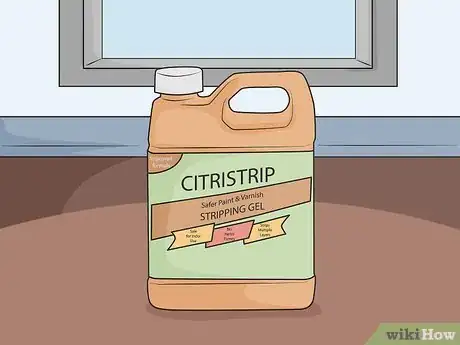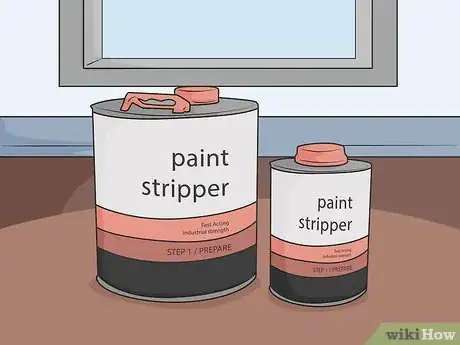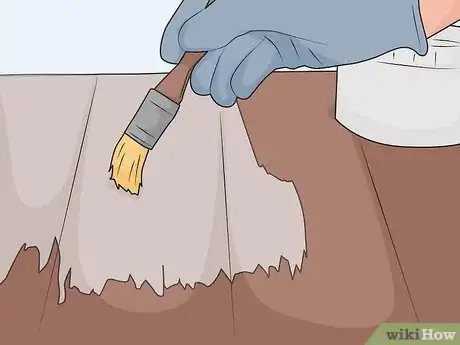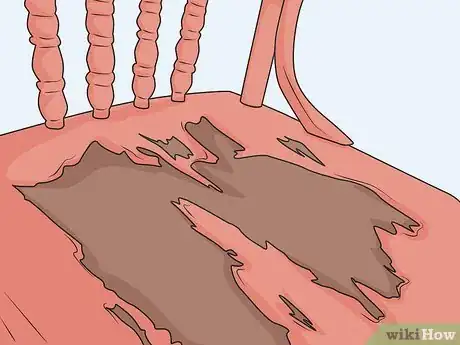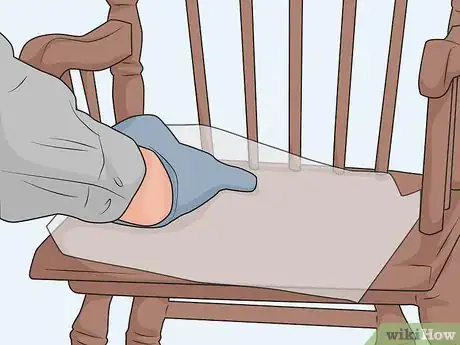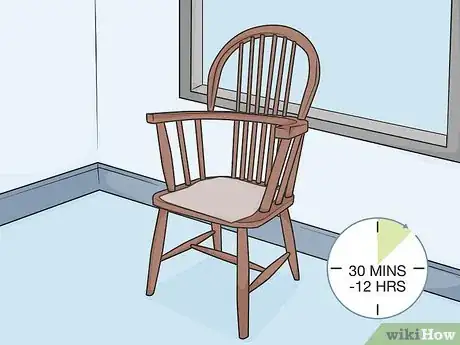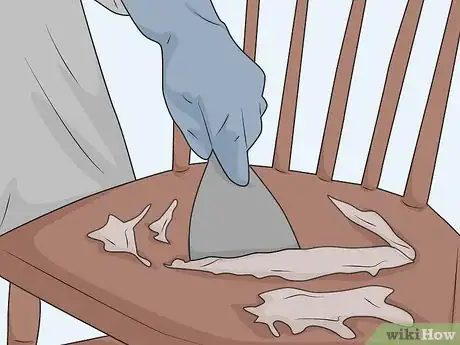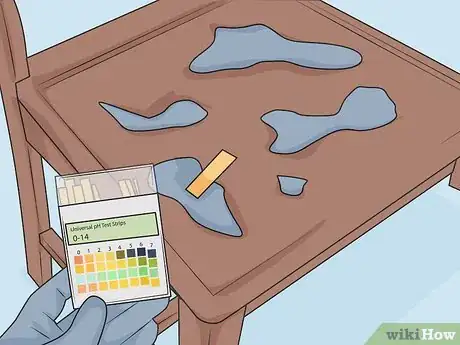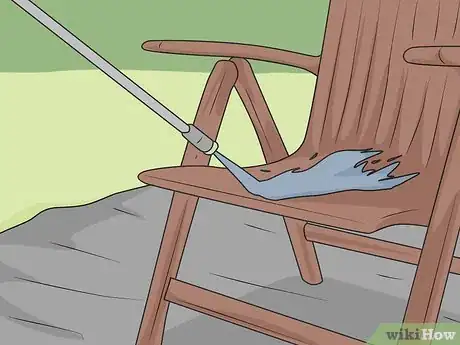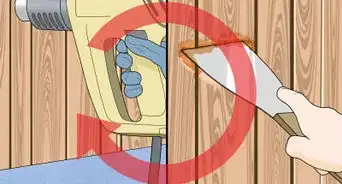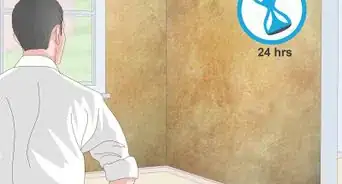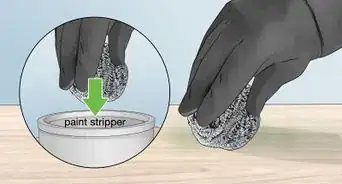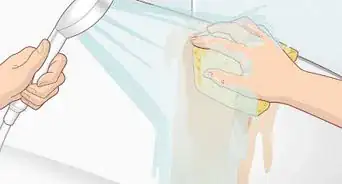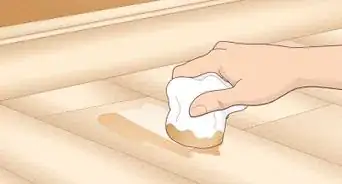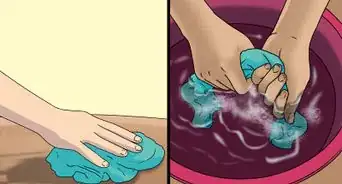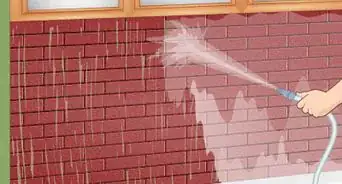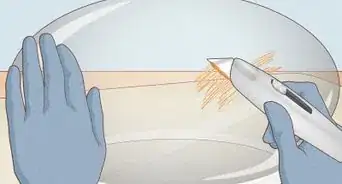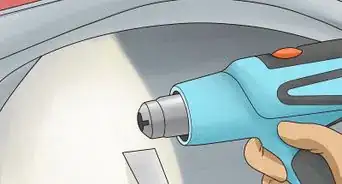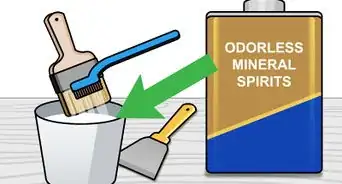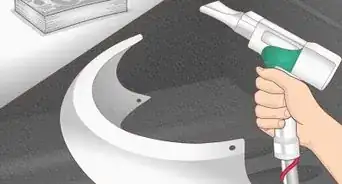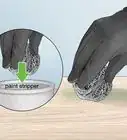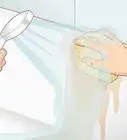This article was co-authored by Kevin Snow and by wikiHow staff writer, Eric McClure. Kevin Snow is a Commercial Painting Professional and the Owner of Ridge Painting Company. With over 12 years of experience, he specializes in painting commercial facilities and new build constructions. Kevin and his team are fully licensed and insured.
There are 12 references cited in this article, which can be found at the bottom of the page.
This article has been viewed 68,837 times.
Primer can be incredibly difficult to take off, but with enough force and enough patience, you can usually remove primer from most surfaces. Different surfaces do require different techniques, though, so you should familiarize yourself with each one to approach the problem area correctly.
Steps
Choosing the Right Stripping Agent
-
1Opt for a caustic stripper to remove primer from concrete or brick. Caustic stripper is a thick, gum-like substance that contains lye. A caustic stripper will not remove primer from plastic and it may be alright with wood, but it is perfect for masonry.[1] Pick up a caustic stripper if you want to strip a brick wall, clean up a primer spill on concrete, or strip paint off of a driveway or sidewalk.[2]
- You must neutralize caustic strippers after you’ve used them, so pick up plenty of white vinegar ahead of time if you’re stripping a larger surface area.
- Popular caustic strippers include Betco’s Extreme, Bolt Ultra Concentrated, and Fiberlock’s NexStrip. This stuff usually comes in a plastic bucket.
Tip: The only difference between paint and primer is that primer seals a surface while paint doesn’t. From a removal perspective, this isn’t important. The chemicals that strip paint will also strip primer.[3]
-
2Choose a biochemical paint stripper to clean primer off of wood. Biochemical stripper is the safest option available since it uses plant-based ingredients to erode paint or primer. This makes it the safest option for wood, but it may not be strong enough for metal, concrete, or stronger surfaces.[4]
- This type of stripper is the least likely to damage your surface. If you have primer on a model airplane, piece of art, or some other delicate surface, try using a biochemical stripper first.
- Citri-Strip is probably the most popular biochemical paint stripper, but SmartStrip and Franmar are great options as well. These strippers often come in plastic containers that resemble laundry detergent or insecticide.
Advertisement -
3Get heavy-duty solvent for metal, plastic, or to take stubborn primer off. If the primer is especially thick, old, or you have primer on a metal or plastic surface, get a heavy-duty paint stripper. Heavy-duty paint stripper is extremely strong, but it’ll get primer off of basically any surface. Keep in mind, this stuff is really toxic so you shouldn’t use it unless you have to.[5]
- Heavy-duty solvent will also work on wood or masonry, but this is overkill.
- When it comes to paint strippers, heavy-duty is typically code for high-VOC. VOCs, or volatile organic compounds, are pretty toxic so work in a well-ventilated area and put on safety gear when using this kind of stripper.
- Heavy-duty solvents include Dumond’s Peel-Away, Old Masters, and Klean-Strip, which is probably the most popular option. These solvents usually come in an aluminum can.
Applying the Stripper
-
1Put on protective eyewear, a dust mask, and thick rubber gloves. Get some protective airtight goggles to keep the fumes out of your eyes. Wear thick rubber gloves over long sleeves to keep the stripper off of your skin. If you’re using a caustic or biochemical stripper, put on a dust mask. If you’re using heavy-duty solvent, wear a respirator.[6]
- Lay a tarp down if you’re stripping primer off of an object or want to keep stripper off of the floor.
Warning: You must wear a respirator if you’re working with a heavy-duty paint stripper. Get a respirator with cartridges rated for organic vapors. These cartridges are color-coded and the organic vapor cartridges are black. The color-coding may be different where you live so read the label on a respirator cartridge before using it.
-
2Spread the stripper on the surface with a disposable paintbrush. Open the stripping agent’s container and pour it into a paint tray. Grab a cheap, disposable paint brush and dip it into the stripping agent. Spread the stripping agent over the surface using back and forth strokes. If you’re stripping wood, apply it in the direction of the grain. Otherwise, go back and forth in any direction to cover the surface.[7]
- Most stripping agents are pretty thick. You may need to reload your brush every 4-5 strokes to keep it from drying out.
-
3Build up a 1⁄8–1⁄2 in (0.32–1.27 cm) layer of stripping agent on the primer. Reload your brush as needed and continue spreading the stripping over the surface. Cover every crack, textured surface, or gap in the material to completely cover the primer. Continue spreading the stripper around until you build up a layer of stripper on the surface.[8]
- Heavy-duty solvents typically require thin layers. You won’t need to build up more than a 1⁄8 in (0.32 cm) layer of stripper on the surface for this agent to be effective.
- Caustic and biochemical strippers often need to be built up in a thicker layer. Read the label to see how thick of a layer you need. Often, you’ll need a 1⁄2 in (1.3 cm) layer of stripper to remove primer.
-
4Lay plastic sheeting over the surface if it came with your stripping agent. Some caustic strippers and a few heavy-duty strippers need to be covered with plastic sheets to work the stripper into the material. If your stripping agent came in a kit with plastic sheets, you must use them. To apply these sheets, spread your first sheet out by hand and press it against the surface you’re stripping. Smooth it out with your palms and press out any air bubbles. The plastic sheeting will automatically adhere to the surface.[9]
- These sheets force the stripper into pores in the surface material. This is particularly important if you’re removing primer from brick.
-
5Wait 30 minutes to 12 hours for the stripper to soak into the primer. The soaking time is listed on your container, so read the label thoroughly to make sure you don’t miss anything.[10] Typically, the stronger the stripping agent, the less time it needs to soak. Wait 30 minutes to 12 hours depending on what the label says to give the stripping agent time to eat away the primer.[11]
- You won’t see the primer falling off of the surface or anything. All the stripper does is weaken the primer to make it easier to remove.
Scraping and Washing the Surface
-
1Use a paint scraper, putty knife, or razor blade to scrape the primer off. Put all of your protective gear back on. Grab a putty knife or paint scraper if you’re removing the stripper from wood or masonry. Opt for a razor blade to peel the stripper off of metal or plastic. Drag the blade of your scraping tool at a 15- to 25-degree angle to the surface to peel the stripper and primer off.[12] Work in vertical or horizontal strips to remove the layers of stripping agent and primer. Continue doing this until the primer and dried out stripping agent is completely gone.[13]
- The stripper will have hardened, so you can work in any order you’d like. You can peel the primer off in vertical or horizontal strips, or work in 2–3 square feet (0.19–0.28 m2) sections until the surface is entirely clean.
- You may need to use a wire brush after you scrape porous surfaces, like brick or concrete.
- This can take a while if you’re removing primer from a larger surface area. Unfortunately, there aren’t any easier ways to do this.
-
2Neutralize the surface in water and vinegar if required by the stripper. Read the label of your stripping agent to see if you need to neutralize the surface when you’re done. If you do, fill a spray bottle with 1-part white vinegar and 1-part tap water. Thoroughly spray the surface area with your vinegar mixture to neutralize the acid from the paint stripper. Let the vinegar soak for a minute or two while you get a testing strip out.[14]
- If you have a smaller object, you can soak it in the vinegar solution for 3-5 minutes if you prefer.
- Most heavy-duty and caustic stripping agents need to be neutralized. Most biochemical strippers do not.
- You cannot neutralize the paint stripper with water alone. This will only spread the acidic agent around on the surface.[15]
-
3Test the surface with a pH testing strip if you neutralized it. Get a pH testing strip and lay it down on a damp portion of the surface you stripped. Let the liquid soak into the strip and wait for the strip to change colors. Use the color-coded reference chart to assess what the pH of your surface is. If it’s at, or relatively close to, 7 pH, you’re done. If the acidity is still too high, mist, wash, or soak the surface in more water and white vinegar before testing it again.[16]
- Any reading lower than a 6.5 pH is considered too acidic. If the surface has an acidic pH, it means that the stripping agent left a residue behind. Your surface may weaken or discolor over time and you may get acidic residue on your hands if you touch the surface.
Warning: If you do not neutralize the stripper, the residual acid will wear away the surface you removed the primer from and damage it over time. You may also end up with small particles of the stripping agent on your skin the next time you touch the surface, which may cause a chemical burn.
-
4Clean the surface in water or mineral spirits if you didn’t neutralize it. If your stripper’s container doesn’t mention anything about neutralizing it, read the label to see if you need to wash the surface with mineral spirits. If you do, pick up some mineral spirits and rinse the surface with them. Otherwise, use regular tap water to rinse the area. Just hose down the surface or pour water over the material to wash off the remaining stripping agent.[17]
- This is an important safety measure. If you don’t neutralize the surface, you must wash it off. If you skip this step, you could end up burning your skin the next time you touch the surface.
- Be careful if you’re working with mineral spirits. Wear protective eyewear and a dust mask. If you get any spirits on your hands, wash them thoroughly with soap and water.
-
5Let the surface air out until it’s completely dry. The amount of time it takes for the surface to dry depends on the material. Metal and plastic willy typically dry pretty quickly, but wood and masonry may take up to 24 hours. Just wait until the surface is completely dry before touching it or doing anything else.[18]
- You can open windows, turn fans on, or let an object sit out in the sun to speed this process up.
Expert Q&A
Did you know you can get premium answers for this article?
Unlock premium answers by supporting wikiHow
-
QuestionHow do you remove excess paint after stripping?
 Kevin SnowKevin Snow is a Commercial Painting Professional and the Owner of Ridge Painting Company. With over 12 years of experience, he specializes in painting commercial facilities and new build constructions. Kevin and his team are fully licensed and insured.
Kevin SnowKevin Snow is a Commercial Painting Professional and the Owner of Ridge Painting Company. With over 12 years of experience, he specializes in painting commercial facilities and new build constructions. Kevin and his team are fully licensed and insured.
Commercial Painting Professional
-
QuestionHow do I remove blueskin primer from concrete?
 wikiHow Staff EditorThis answer was written by one of our trained team of researchers who validated it for accuracy and comprehensiveness.
wikiHow Staff EditorThis answer was written by one of our trained team of researchers who validated it for accuracy and comprehensiveness.
Staff Answer wikiHow Staff EditorStaff Answer
wikiHow Staff EditorStaff Answer -
QuestionHow to remove mapei primer from a metal gray door?
 wikiHow Staff EditorThis answer was written by one of our trained team of researchers who validated it for accuracy and comprehensiveness.
wikiHow Staff EditorThis answer was written by one of our trained team of researchers who validated it for accuracy and comprehensiveness.
Staff Answer wikiHow Staff EditorStaff AnswerMapei primer is a low-voc water-based primer. It isn't particularly strong, so it shouldn't be too hard to remove. Pick up a heavy-duty paint stripping solvent and use a disposable brush to cover the primer in your stripping agent. Read the label on the solvent to see how long it needs to soak and then use a putty knife to scrape the stripper off. The primer should peel right off of the door.
wikiHow Staff EditorStaff AnswerMapei primer is a low-voc water-based primer. It isn't particularly strong, so it shouldn't be too hard to remove. Pick up a heavy-duty paint stripping solvent and use a disposable brush to cover the primer in your stripping agent. Read the label on the solvent to see how long it needs to soak and then use a putty knife to scrape the stripper off. The primer should peel right off of the door.
Warnings
Things You’ll Need
Choosing the Right Stripping Agent
- Caustic stripper
- Biochemical paint stripper
- Heavy-duty paint stripping solvent
Applying the Stripper
- Protective eyewear
- Rubber gloves
- Long-sleeve clothing
- Dust mask or respirator
- Paint tray
- Paintbrush
- Drop cloth (optional)
- Plastic sheeting (optional)
Scraping and Washing the Surface
- Paint scraper, putty knife, or razor blade
- Water
- Vinegar
- Mineral spirits or water
- Wire brush (optional)
References
- ↑ Kevin Snow. Commercial Painting Professional. Expert Interview. 23 March 2022.
- ↑ https://www.bobvila.com/articles/best-paint-stripper/
- ↑ http://buildipedia.com/at-home/design-remodeling/paint-vs-primer
- ↑ https://www.bobvila.com/articles/best-paint-stripper/
- ↑ https://www.bobvila.com/articles/best-paint-stripper/
- ↑ https://www.popularmechanics.com/home/outdoor-projects/how-to/a5888/how-to-safely-remove-paint/
- ↑ https://www.bobvila.com/articles/best-paint-stripper/
- ↑ https://www.bobvila.com/articles/how-to-remove-paint-from-trim-and-molding/
- ↑ https://youtu.be/0fj3W2otrs0?t=71
- ↑ Kevin Snow. Commercial Painting Professional. Expert Interview. 23 March 2022.
- ↑ https://www.bobvila.com/articles/how-to-remove-paint-from-trim-and-molding/
- ↑ Kevin Snow. Commercial Painting Professional. Expert Interview. 23 March 2022.
- ↑ https://www.thisoldhouse.com/woodworking/21018208/how-to-strip-paint-from-wood
- ↑ https://www.bobvila.com/articles/best-paint-stripper/
- ↑ https://www.cmmonline.com/articles/cleaning-myths-by-the-dozen
- ↑ https://www.bobvila.com/articles/best-paint-stripper/
- ↑ https://paintedzone.com/how-to-use-a-paint-stripper/
- ↑ https://paintedzone.com/how-to-use-a-paint-stripper/
- ↑ https://youtu.be/3DOl-t6ET0M?t=41
- ↑ https://youtu.be/hfGSSTP9oVA?t=220
- ↑ https://youtu.be/qsHiGnrO23k?t=61
- ↑ https://www.bobvila.com/articles/best-paint-stripper/
- ↑ https://www.bobvila.com/articles/best-paint-stripper/
